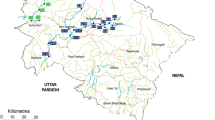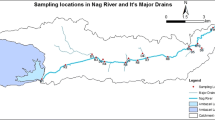Abstract
Detecting homogeneous regions in the Nile River is essential in carrying mathematical modelling. The aim of this paper is to indentify homogenous regions with respect to water quality. Eight years data were subjected to principal components analysis (PCA) to define the parameters responsible for the variability in water quality. The PCA produced three variates (or principal components). For the Nile stem, variates are related to bacterial pollution, organic pollution and then agricultural/nutrients. As for the Nile branches, variables group as coming from bacterial and organic sources, while the agricultural/nutrients stamp is more visible in summer. Then, cluster analysis (CA) was performed to verify whether the observations could be grouped into spatially coherent patterns. CA grouped sampling sites into three homogenous regions: upper, middle and lower Nile stem. To interpret the subdivision, CA was performed on municipal and demographic data coming from Nile governorates, such as potable water consumption, sewage collection, cultivated areas and population data. The cultivated areas group similarly to nutrients water quality data and the percentages of uncollected sewage group similarly to bacterial data. The consecutive use of PCA and CA enabled to determine the main sources of pollution and to identify homogeneous regions with respect to water quality variables.






Similar content being viewed by others
References
Abdel-Dayem S, Abdel-Ghani MB (1992) Concentration of agricultural chemicals in drainage water. Proceedings of the 6th Conference International Drainage Symposium. Nashville, Tennessee, USA, 1992
Abdel Gawad S, Khalil B, Awadallah AG (2005) Statistical assessment of a water quality monitoring system using principal components and cluster analyses. J Eng Appl Sci, Faculty of Engineering, Cairo University 52:1083–1101
Abdel-Dayem S (1994) Water quality issues in Egypt. Italian-Egyptian study days on the environment, Cairo, 9–20 October, 81–92
Ameh EG, Akpah FA (2011) Heavy metal pollution indexing and multivariate statistical evaluation of hydrogeochemistry of River PovPov in Itakpe Iron-Ore mining area, Kogi State, Nigeria. Pelagia Research Library, Adv Appl Sci Res 2:33–46
Amiri BJ, Nakane K (2009) Modeling the linkage between river water quality and landscape metrics in the Chugoku District of Japan. Water Resour Manag 23:931–956
Anderson TW (1984) An introduction to multivariate statistical analysis. Wiley series in probability and mathematical statistics, Second edition
Anderson TW, Darling DA (1952) Asymptotic theory of certain “goodness-of-fit” criteria based on stochastic processes. Ann Math Stat 23:193–212
APHA. (1999) Standard methods for the examination of water and wastewater. American Public Health Association, 17th Ed., Washington DC., USA, 20th edition; 1325 p
Awadallah RM, El-Haty MT, Soltan ME (1991) Ahmed IA. Characterization of the Nile water quality in the zone from Aswan to Giza Delta. J Sci, Egypt 15:84–104
Carreira PM, Marques JM, Pina A, Mota Gomes A, Galego Fernandes PA, Monteiro Santos F (2010) Groundwater assessment at Santiago Island (Cabo Verde): a multidisciplinary approach to a recurring source of water supply. Water Resour Manag 24:1139–1159
Dominguez-Granda L, Lock K, Goethals PLM (2011) Application of classification trees to determine biological and chemical indicators for river assessment: case study in the Chaguana watershed (Ecuador). J Hydroinformatics 13:489–499
El-Shanshoury M, Abdel-Bary M (1990) Impact of industrial waste influent on River Nile water quality. National seminar on physical response of the River Nile to interventions Cairo, Nov. 12–13, 1990
El-Sheekh M (2009) River Nile pollutants and their effect on life forms and water quality. Monographiae Biologicae 89(V):395–405
El-Taweel GE, Shaban AM (2003) Microbiological monitoring and evaluation of River Nile water at Cairo segment and Ismailia Canal. Egypt J Microbiol 38:169–182
Gamble A, Babbar-Sebens M (2011) On the use of multivariate statistical methods for combining in-stream monitoring data and spatial analysis to characterize water quality conditions in the White River basin, Indiana, U.S.A. Environmental. Monitoring Assessement (in press); article first published online: 1 April 2011, doi:10.1007/s10661-011-2005-y
Haag I, Westrich B (2002) Processes governing river water quality identified by principal component analysis. Hydrolog Process 16:3113–3130
Helena B, Pardo R, Vega M, Barrado E, Fernandez L (2000) Temporal evolution of groundwater composition in an alluvial aquifer (Pisuerga River, Spain) by principal component analysis. Water Res 34:807–816
Khalil B, Ouarda TBMJ, St-Hilaire A (2011) A statistical approach for the assessment and redesign of the Nile Delta drainage system water-quality-monitoring locations. J Environ Monit 13:2190–2205
Koklu R, Sengorur B, Topal B (2010) Water quality assessment using multivariate statistical methods—a case study: Melen River system (Turkey). Water Resour Manag 25:959–978
Lebart L, Morineau A, Warwick KM (1995) Multivariate descriptive statistical analysis. John Wiley & Sons
Lilliefors H (1967) On the Kolmogorov–Smirnov test for normality with mean and variance unknown. J Am Stat Assoc 62:399–402
Mahloch J (1975) Multivariate techniques for water quality analysis. ASCE J Environ Eng Div 100(EE5):1119–1132
Mahrous YM (1997) Sources of River Nile water pollution from Assuit to Cairo and the evaluation of its effect on the water quality. J Environ Sci 13:45–65
Meng SX, Maynard JB (2001) The use of statistical analysis to formulate conceptual models of geochemical behaviour: water chemical data from the Botucatu aquifer in the Sao Paulo state, Brazil. J Hydrol 250:78–97
MPWWR (1982) Law no. 48/1982. Protection of the Nile River and its water ways against pollution. Issued on the 21st of June 1982 by the Ministry of Public Works and Water Resources, in Arabic
Nouri J, Karbassi AR, Mirkia S (2008) Environmental management of coastal regions in the Caspian Sea. Int J Environ Sci Tech 5:43–52
Pinto U, Maheshwari BL (2011) River health assessment in peri-urban landscapes: an application of multivariate analysis to identify the key variables. Water Res 45:3915–3924
Rabeh SA (2009) Bacteria and viruses in the Nile. Monographiae Biologicae 89(V):407–429
Rifaat A, Mohamed I (2004) Water quality assessment of the River Nile system: an overview. Biochem Environ Sci 17:87–100
Sedeño-Díaz JE, López-López E (2007) Water quality in the Río Lerma, Mexico: an overview of the last quarter of the twentieth century. Water Resour Manag 21:1797–1812
Shaban M, Urban B, El Saadi A, Faisal M (2010) Detection and mapping of water pollution variation in the Nile Delta using multivariate clustering and GIS techniques. J Environ Manage 91:1785–1793
Shapiro SS, Wilk MB (1965) An analysis of variance test for normality (complete samples). Biometrika 52:591–611
Shrestha S, Kazama F (2007) Assessment of surface water quality using multivariate statistical techniques: a case study of the Fuji river basin. Japan. Environ Model Software 22:464–475
Singh KP, Malik A, Mohan D, Sinha S (2004) Multivariate statistical techniques for the evaluation of spatial and temporal variations in water quality of Gomti River (India): a case study. Water Res 38:3980–3992
Singh KP, Malik A, Mohan D, Sinha S (2005) Water quality assessment and apportionment of pollution sources of Gomti River (India) using multivariate statistical techniques: a case study. Anal Chim Acta 538:355–374
Sliva L, Williams DD (2001) Buffer zone versus whole catchment approaches to studying land use impact on river water quality. Water Resour Res 35:3462–3372
Statsoft (1994) Statistica volume III. Statistics II
Talling JF (2009) Physical and chemical water characteristics. Monographiae Biologicae 89(V):367–394
Varol M, Gökot B, Bekleyen A, Şen B (2011) Water quality assessment and apportionment of pollution sources of Tigris River (Turkey) using multivariate statistical techniques—a case study. River Research and Applications (in press), article first published online: 10 May 2011, doi:10.1002/rra.1533
Vega M, Pardo R, Barrado E, Deban L (1998) Assessment of seasonal and polluting effects on the quality of river water by exploratory data analysis. Water Res 32:3581–3592
Worral F, Burt T, Adamson J (2003) Controls on the chemistry of runoff from an upland peat catchment. Hydrolog Process 17:2063–2083
Yousry M, Awadallah AG, Salem T (2011) Assessment of Nile water quality data using exploratory data analysis and clustering of variables. Geosci Res 2:49–61
Zhao J, Fu G, Lei K, Li Y (2011) Multivariate analysis of surface water quality in the Three Gorges area of China and implications for water management. J Environ Sci 23:1460–1471
Zou S, Yu YS (1996) A dynamic factor model for multivariate water quality of time series with trends. J Hydrol 178:381–400
Author information
Authors and Affiliations
Corresponding author
Rights and permissions
About this article
Cite this article
Awadallah, A.G., Yousry, M. Identifying Homogeneous Water Quality Regions in the Nile River Using Multivariate Statistical Analysis. Water Resour Manage 26, 2039–2055 (2012). https://doi.org/10.1007/s11269-012-9997-0
Received:
Accepted:
Published:
Issue Date:
DOI: https://doi.org/10.1007/s11269-012-9997-0




